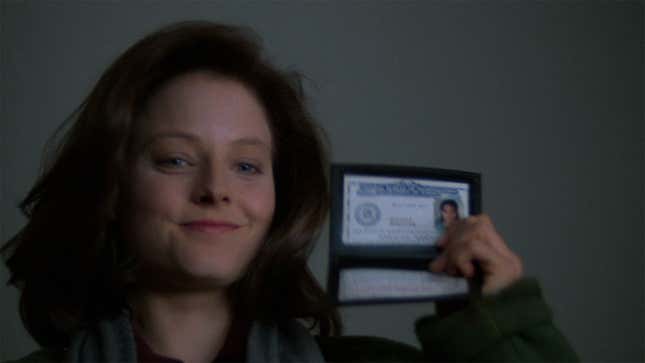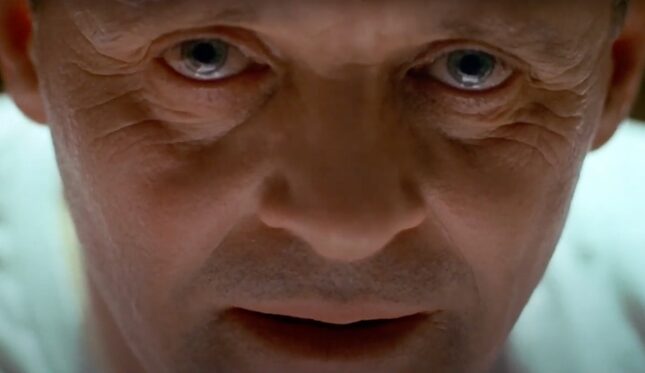

Almost 30 years after its release, Jonathan Demme’s The Silence of the Lambs still shocks me. No matter how much I’m convinced that I love it, no matter how many scenes I can practically recite verbatim, upon each repeat viewing I’m never not astounded by how fucking good this movie is. It’s always better than I remembered, a film that manages to be compulsively watchable despite its insistence that you ponder unimaginable horrors and regular presentation of can’t-unsee-able images. The Silence of the Lambs is awfully elegant for a movie so concerned with torture, cannibalism, and the skinning of humans.
And all of this is despite the way jokey references to the movie within the broader culture have threatened to neutralize some of its most horrific and singular elements. Fava beans and a nice chianti. “I’d fuck me.” “Love your suit.” “Hello Clarice.” “Goodbye Horses.” “Was she a great big fat person?” The masks strapped onto Lecter to keep him from biting people’s faces off. Before there was such a thing as memes, The Silence of the Lambs was already spawning several. Such is the way of a cultural phenomenon that appealed to genre fans, critics, and Oscar voters alike. To this day, it’s one of just three movies to sweep the Big Five categories of the Academy Awards (Best Picture, Best Director, Best Actor, Best Actress, and Best Adapted Screenplay).
‘If the movie were not so well made, indeed, it would be ludicrous,’ Roger Ebert wrote in his review pegged to the film’s release.
And yet while anyone with pop-cultural literacy already knows this stuff several times over, The Silence of the Lambs is still effectively harrowing. “If the movie were not so well made, indeed, it would be ludicrous,” Roger Ebert wrote in his review pegged to the film’s release. I agree. Director Jonathan Demme has his characters frequently stare directly into the camera, locking the audience in its crosshairs and transmitting empathy (that sometimes comes via the terror in its characters’ eyes). The muted color scheme and shadowy textures coat the story in the specific grit of early-’90s cinema—I can’t imagine this movie being made at any other time. And, in fact, none of the entries in what would become a franchise (that actually started with Michael Mann’s 1986 thriller Manhunter) ever managed to work their way under viewers’ fingernails with such tenacity.
The performances are ingenious. In a commentary originally recorded in 1994 but featured in Criterion’s most recent deluxe release of the film (featuring a gorgeously grainy 4K transfer), director Jonathan Demme notes that Jodie Foster is underrated as a physical actor during a climactic scene when she has to load a gun while stunned and having just been knocked down on the floor. More subtle is the autopsy scene that she winces through while rattling off the young female victim’s physical attributes. It’s supposed to be a dry inventory, but her emotional reaction makes it human. Anthony Hopkins manages something operatic, taking Hannibal Lecter over the top while keeping him down to earth. He is believably unbelievable, a nuanced movie monster. Ted Levine as Jame “Buffalo Bill” Gumb is utterly possessed. There’s an entirely separate world happening behind his eyes that we see only glimpses of. When his prisoner Catherine (Brooke Smith) lures his beloved toy poodle Precious into the dried-up well in which she’s being kept, she cries out to Bill, “Don’t make me hurt your dog!” In return, Bill spits, “You don’t know what pain is!” Perhaps this is intended as a threat, but I always read it as an encapsulation of Bill’s pathos, a rather eloquent illustration of the way tragedy begets tragedy. Hurt people hurt people, goes the saying.
The Silence of the Lambs is an established classic, a virtually unanimous favorite of moviegoers, no matter on what side of the high/low cultural spectrum their tastes fall. This is settled and unimpeachable. (Though I’d love to read a reasoned takedown of this movie, I just haven’t come across one.) Of particular note is the care all involved take to sketch out Clarice’s interior life, specifically the parts of it formed by being a woman in a world full of condescending men. As an FBI trainee, she is stared down, solicited, and at one point, ejaculated on by the men she encounters. Demme deliberately cast tall men to emphasize the physical power that Clarice’s colleagues and peers could wield. Without a romantic subplot, she is sexually ambiguous. She announces flatly that she isn’t interested in Lecter’s suggestion that her FBI boss Jack Crawford (Scott Glenn) may be lusting over her. To do her job, Clarice must withstand a lot of inappropriate behavior and comments, and though she does so graciously (which seems more pragmatic than polite), viewers remain aware of the Herculean effort of her tolerance.
Decades later, the majority of movies being made still don’t come close to interrogating male gaze.
While dissecting the notion of “male gaze” was still largely confined to academic circles, Demme, his screenwriter Ted Tally (who based his script on Thomas Harris’s novel of the same name), and especially Foster were presenting what it looked and felt like to a mass audience. Decades later, the majority of movies being made still don’t come close to interrogating male gaze. The Silence of the Lambs was so ahead of its time that time still hasn’t caught up.
And yet, it was still very much a product of its time. It is the Buffalo Bill character that warrants the most scrutiny in a modern viewing. The transformation-obsessed Bill’s m.o. is to build a suit of flesh out from his women victims. The movie is careful not to group him with “transsexuals,” per the terminology of the time. “There’s no correlation in the literature between transsexualism and violence. Transsexuals are very passive,” explains Clarice. In a deleted scene set at Johns Hopkins, Crawford explains that Bill isn’t a transsexual but he thinks he is. Ted Levine, the actor who played Bill, claimed:
The stance I took was more of an acutely homophobic heterosexual man doing that mocking thing. I kind of took it that he was sort of imitating the way his mother might have talked to the poodle. By hearing that voice, in a sense he’s sort of talking to himself. His inner poodle as it were. The other thing he’s not is he’s not a transvestite either or a transexual. He was playing with these ideas and he’s tried on a whole lot of personas, and just got hooked on this idea of dressing in a women’s skin.
There’s a reference on this Jame Gumb wiki that I believe is sourced from Harris’s novel (I haven’t read it in forever): “Believing himself to be transsexual, Gumb began applications for gender reassignment surgery and applied to schools such as Johns Hopkins. However, all of his applications were declined. The hospitals’ vetting process deemed Gumb too psychologically disturbed and not fitting the profile of a true transgender person.”

While I think letting characters live in gray areas is the most realistic thing an author can do, a lot of this reads like a display of mental gymnastics. It is fair to say that Bill, who was modeled in part on serial killer Ed Gein (who is said to have contemplated gender reassignment, or “sex-change surgery,” as it was referred to at the time), appears to exhibit some form of gender dysmorphia and in fact that dysmorphia informs the suffering he inflicts on his victims. He may not have fit the profile of a trans person, as it was understood in 1991, but he certainly resides somewhere on the queer spectrum. His nonconforming relationship to his gender is meant to horrify: The scene in which he applies makeup and a wig (ripped from a human scalp) and videotapes himself lip-syncing to Q. Lazzarus’s “Goodbye Horses” climaxes with him tucking his genitalia between his legs and stepping into frame to approximate his idea of a female form. It’s calculated to shock and appears to be intended as the movie’s Grand Guignol. Bill’s gender identity is supposed to freak you out.
Like Cruising, Lambs was met with protests from queer activists. In a retrospective documentary included on Lambs home-video releases (including the aforementioned Criterion edition), Foster dismissed the criticism as “a superficial reading.” Demme conceded that the movie may have tumbled into “a tradition of negative gay stereotypes in movies,” but nonetheless felt that, “Some individuals were quick to pounce on the character in an oversimplified way.”
Buffalo Bill is a challenge to a compassionate viewer in 2020 because he is so scary and awful while at the same time, his relationship to gender is pathologized by his (ostensibly) straight, cisgender creators. The “not all trans people” sentiment of Lambs’ characters reads more like an excuse than the product of a rigorous understanding of gender identity. The ignorance that Buffalo Bill’s characterization suggests threatens to mar a movie that is otherwise about as objectively perfect as movies get.
I chatted with my colleague Joan about this point earlier this week and she gave me her perspective as a trans person who loves The Silence of the Lambs:
The spectre of transness in the film doesn’t feel familiarly transmisogynistic the way most depictions of trans women in ’80s and ’90s films do. I don’t look at Buffalo Bill and think: “This is a trans person.” Bill feels more like a boogeyman, conjured up from the societal subconscious, a fear about something that never existed anyway. If Buffalo Bill were a more average depiction of an HIV positive cross-dresser with a murder habit, I would definitely feel different. But his monstrousness is like… otherworldly, and unfamiliar to me, so I feel less weird engaging with it.
This is more or less how I feel about the movie, and it hits at the sort of contract I make with a piece of fiction whose focus is on things that would be nearly impossible to bear in real life: I say to myself, “It’s only a movie.” This is not to underplay the importance of representation, and indeed the anti-Lambs activists were correct in pointing out that there was such a dearth of queer representation that even the suggestion of it was a high-stakes endeavor that the makers of this movie very clearly did not consider the weight of. But connecting with monsters onscreen almost always requires some process of disconnecting from reality and it is The Silence of the Lambs’ unique genius that makes crossing such a boundary virtually unconscious and reflexive.